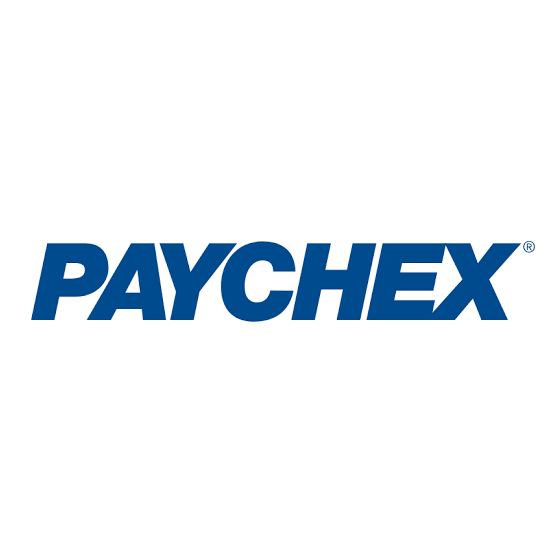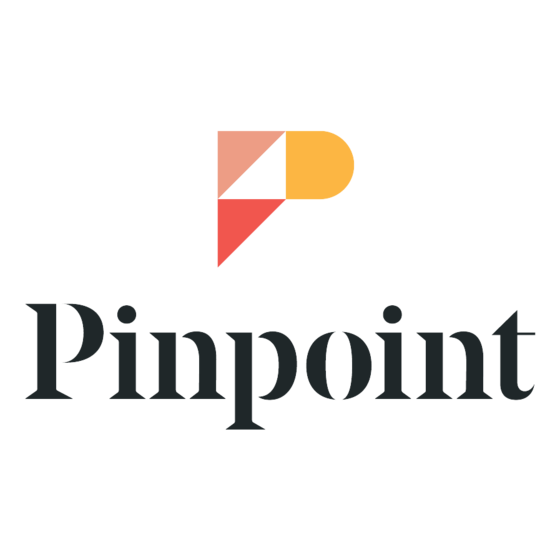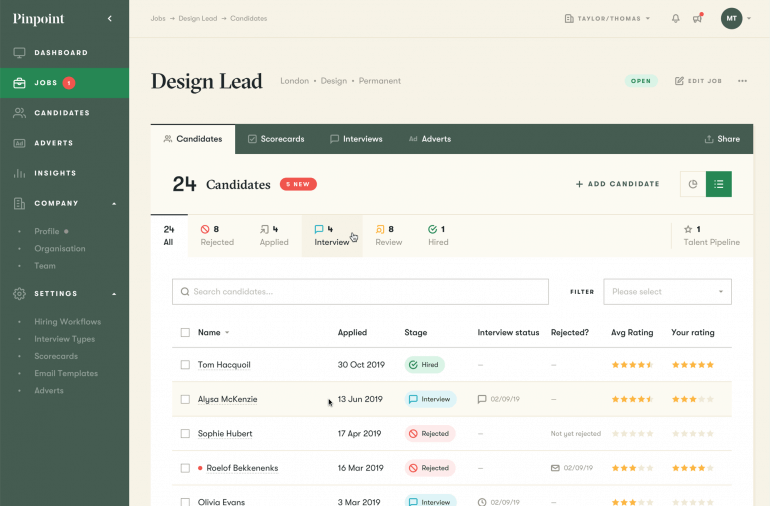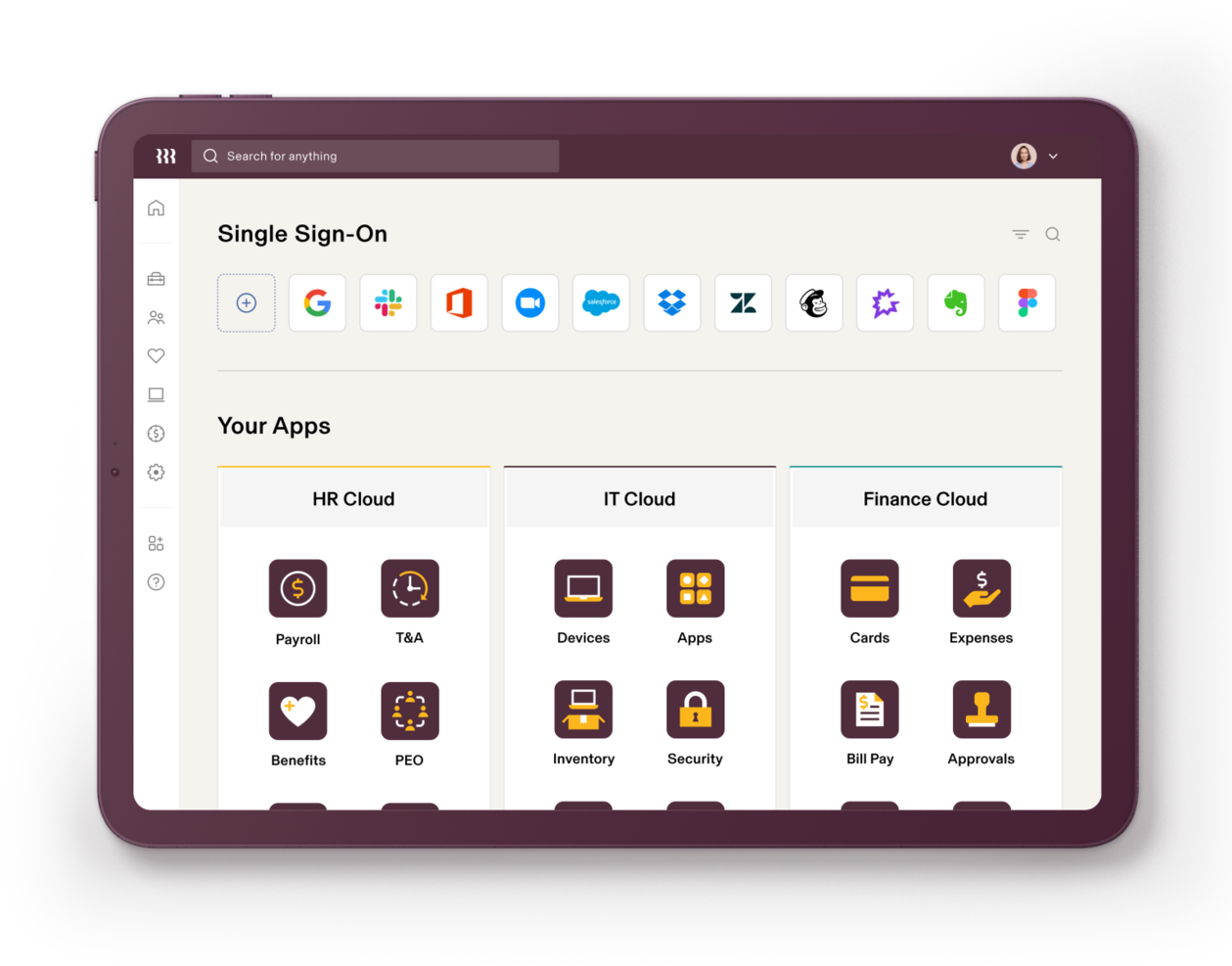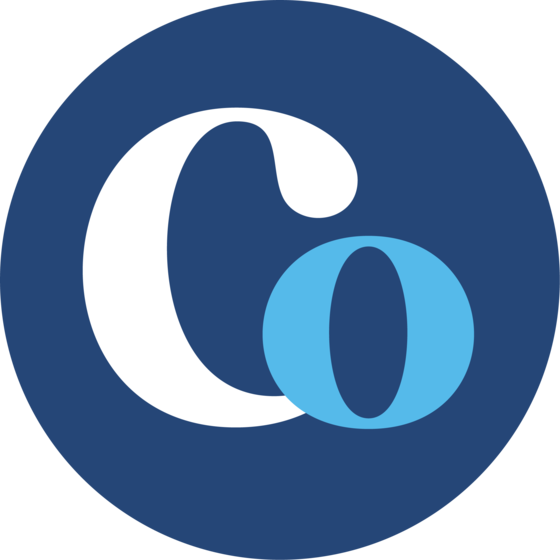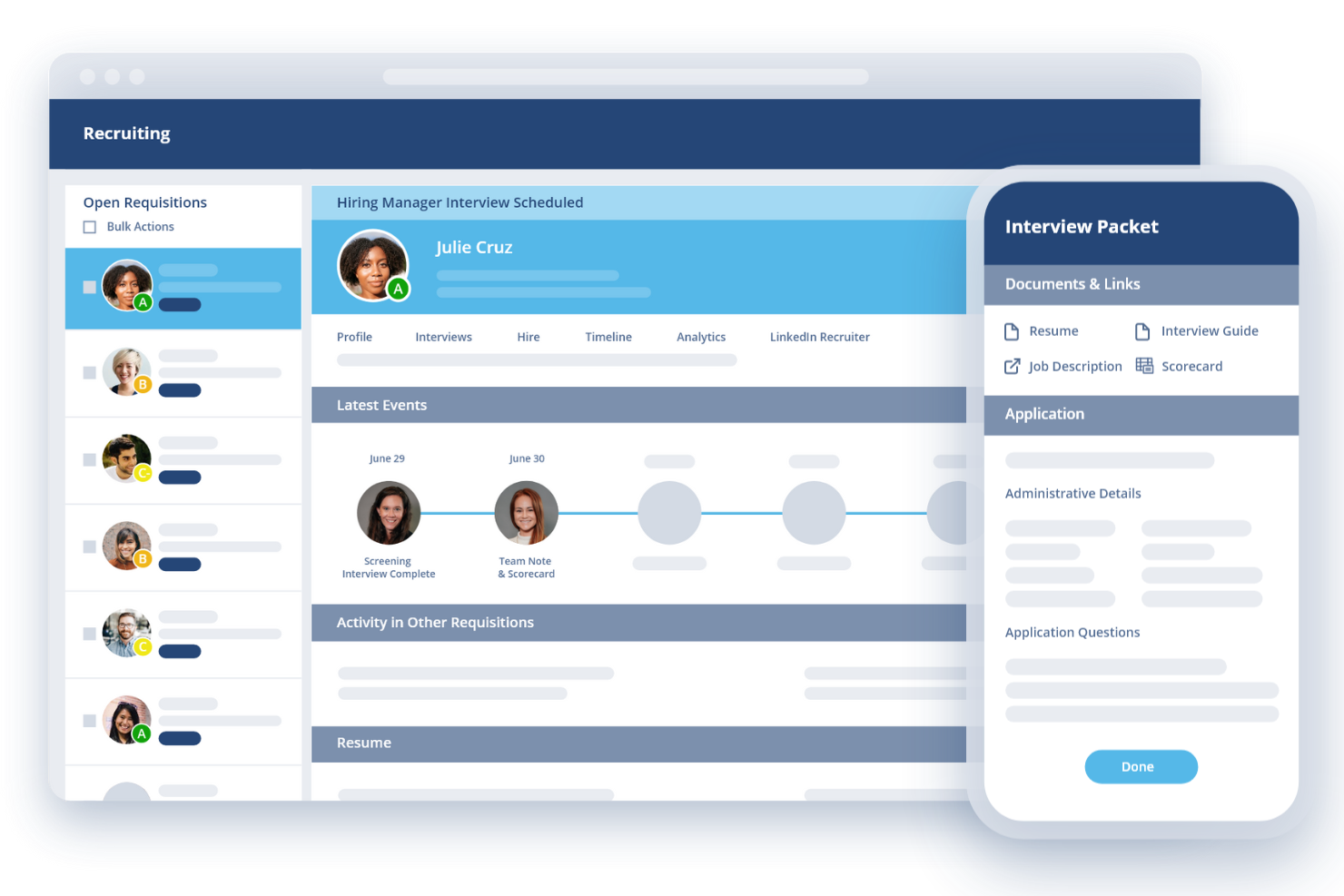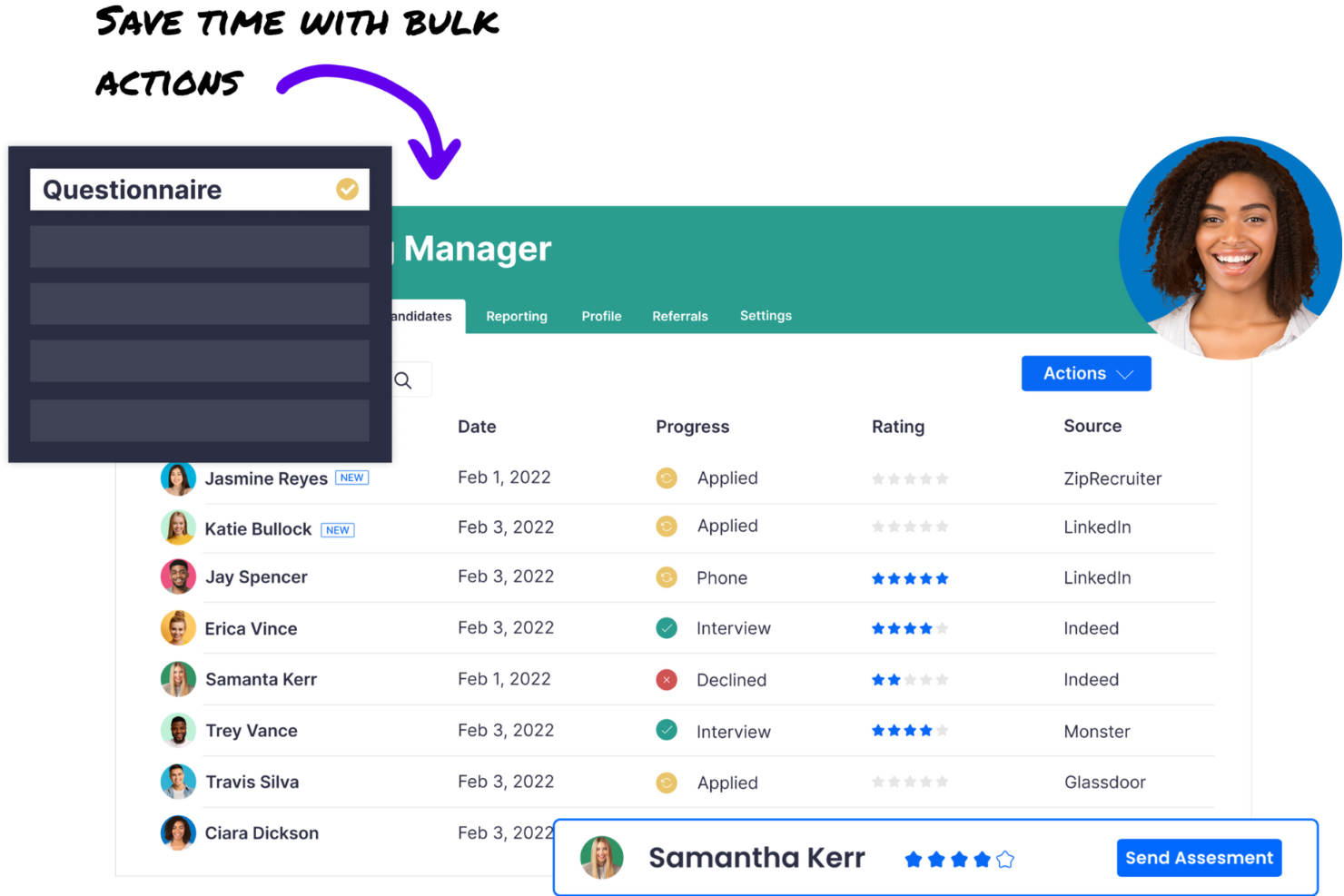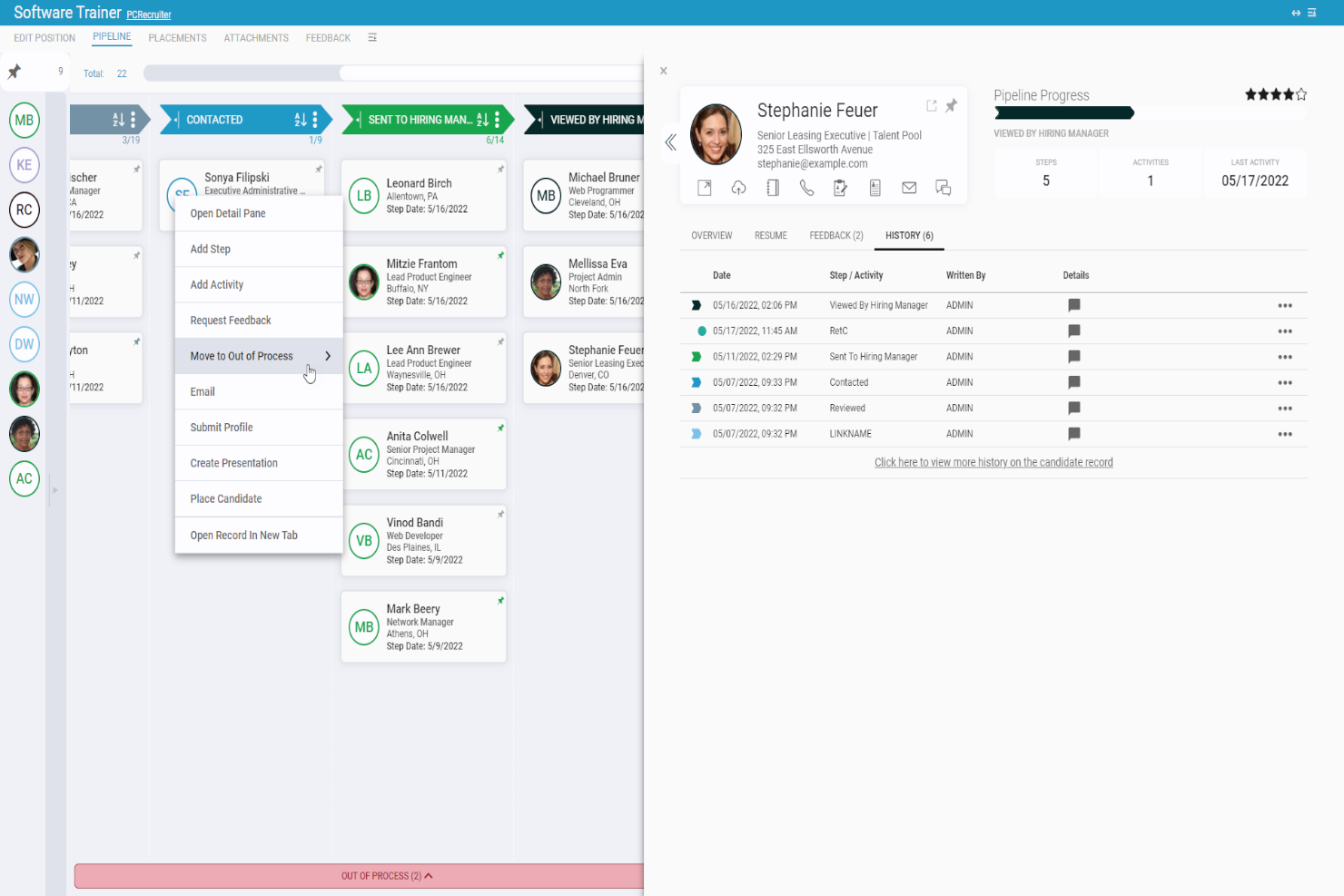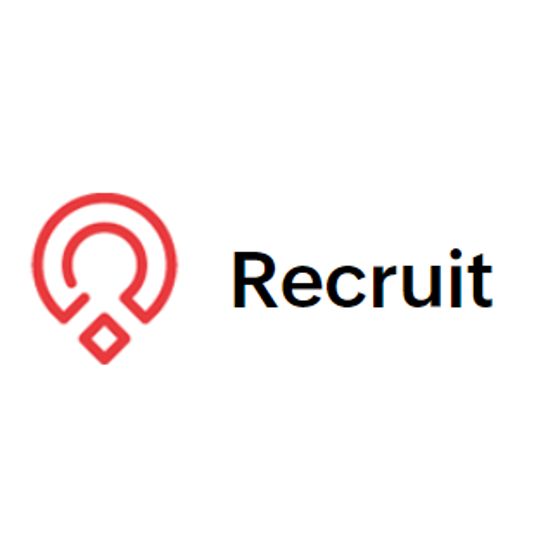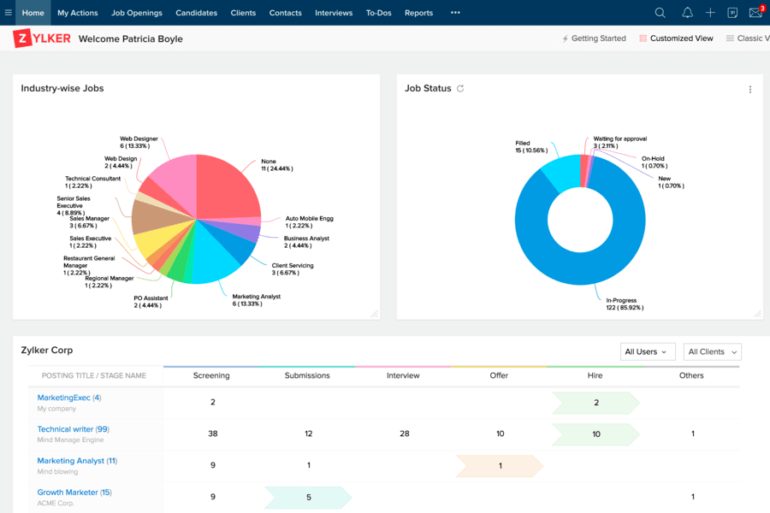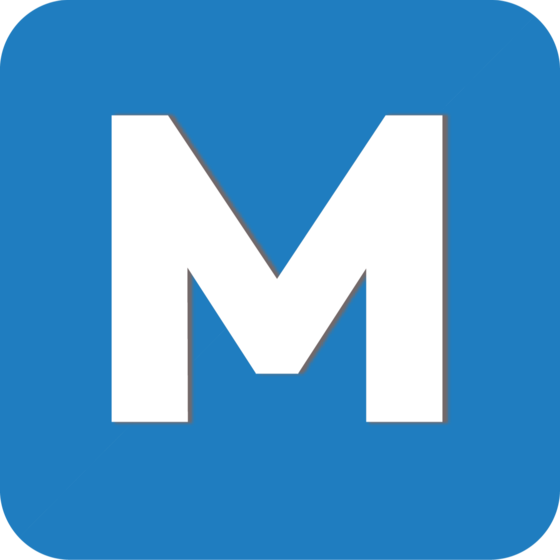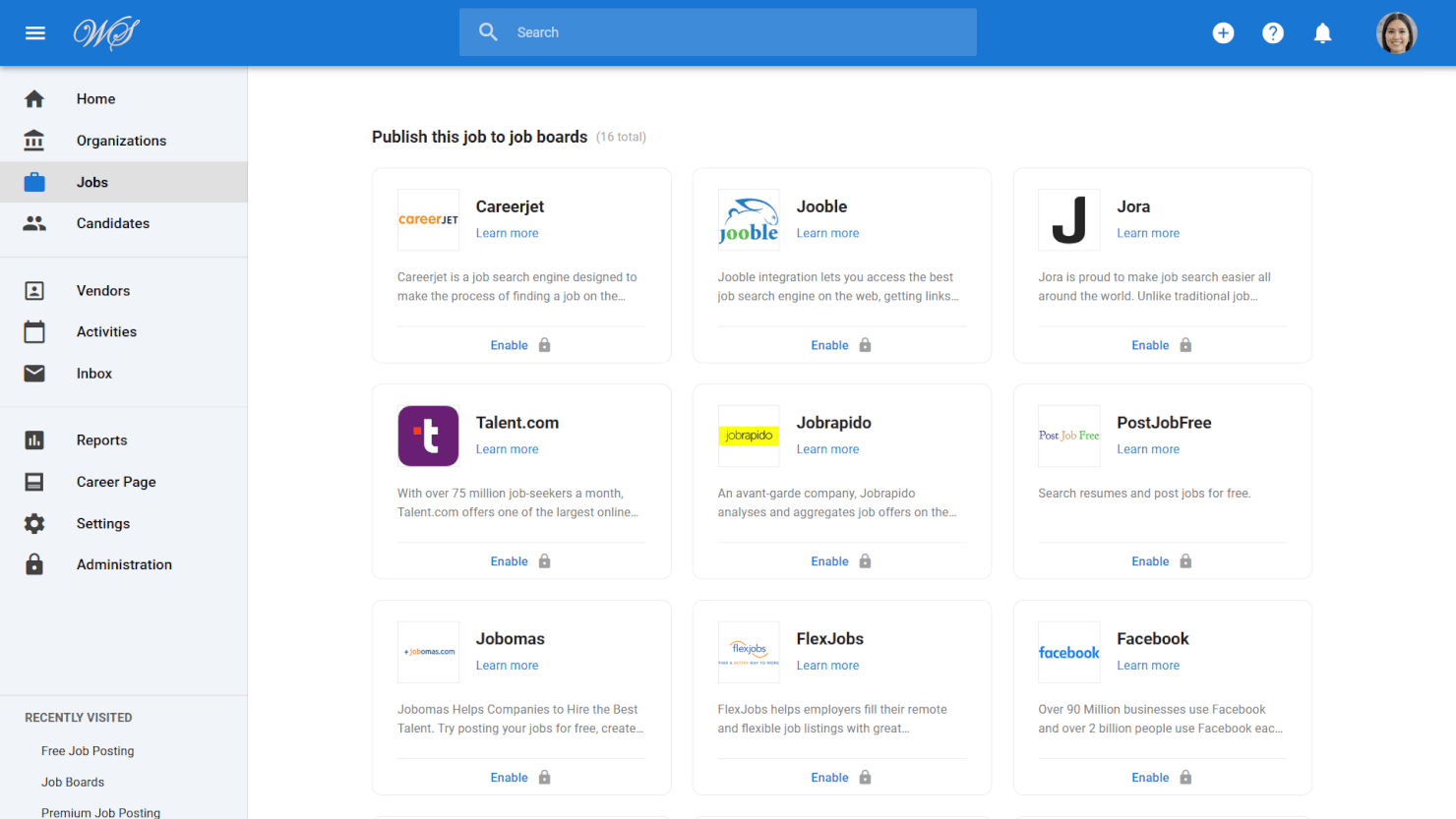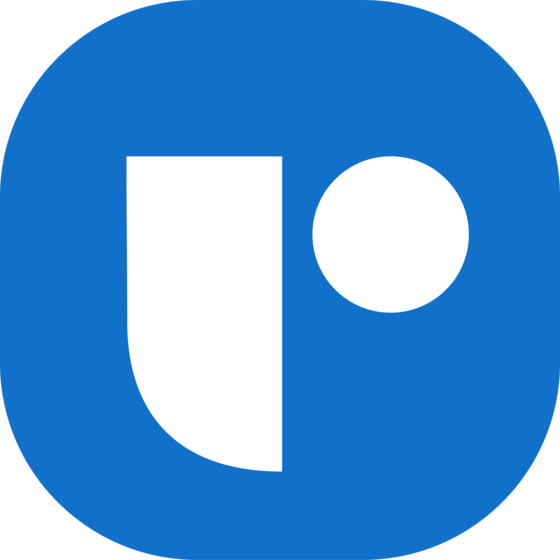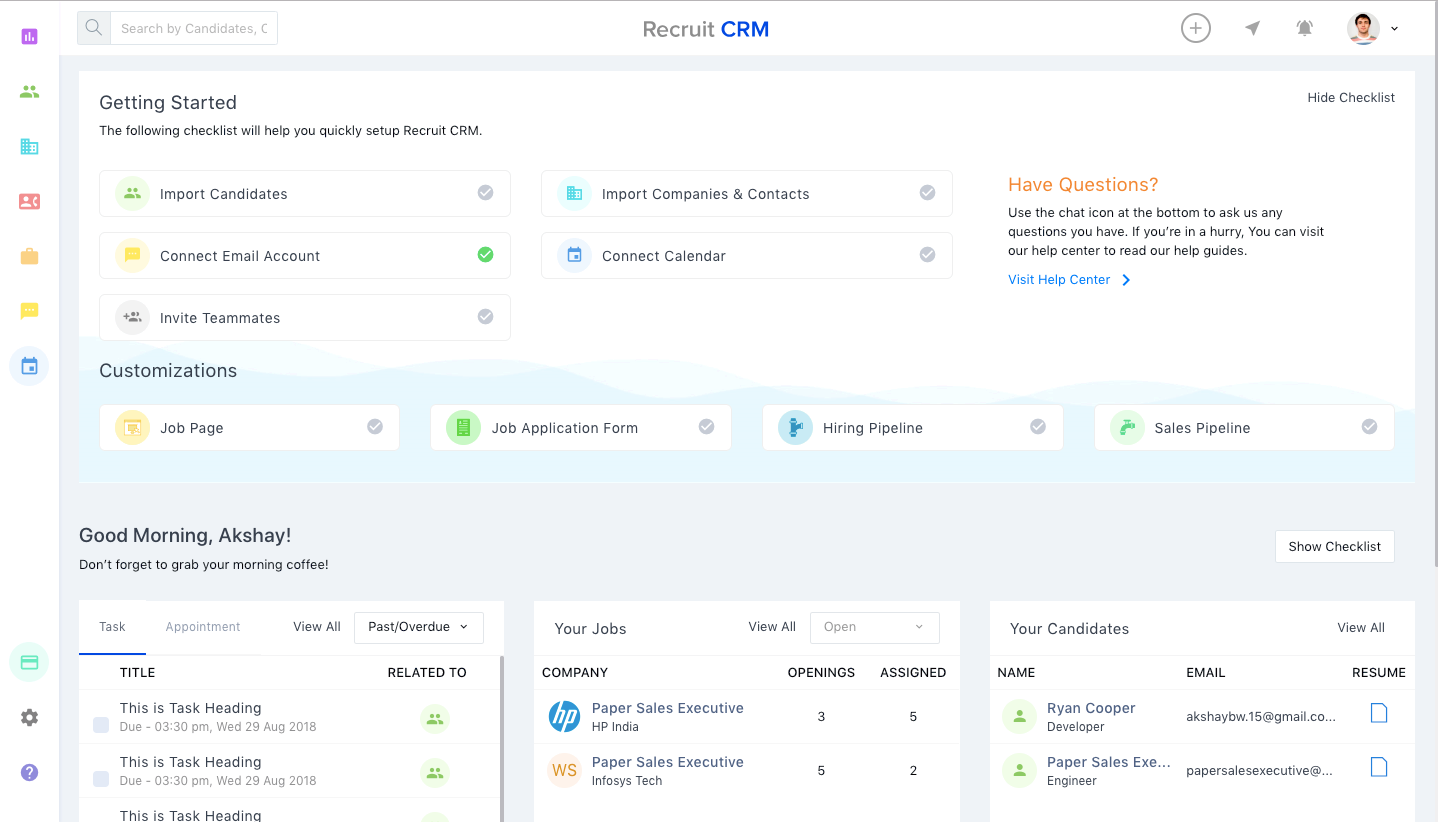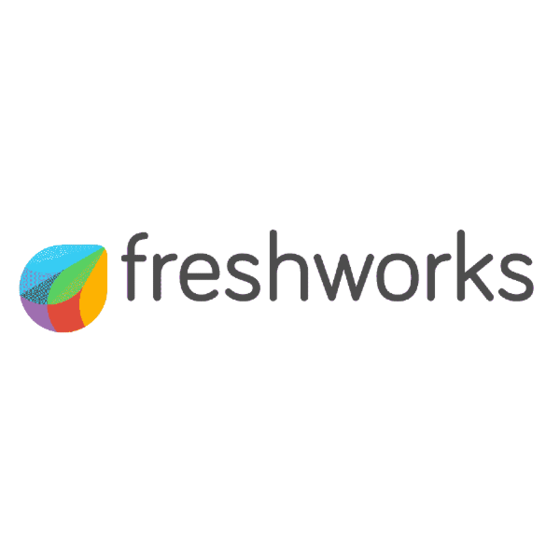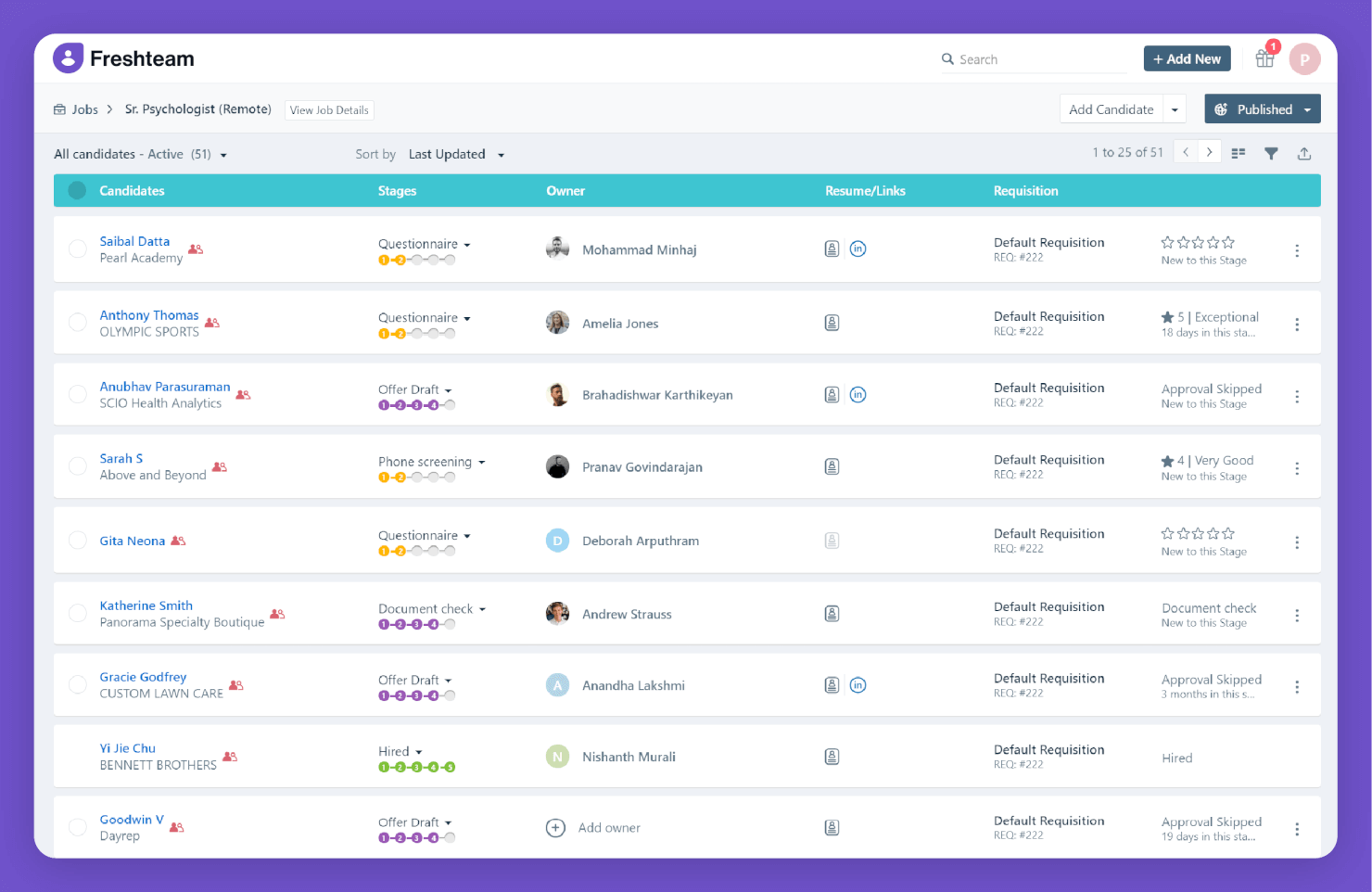10 Best Applicant Tracking Systems Shortlist
Here's my pick of the 10 best software from the 30 tools reviewed.
Get free help from our HR software advisors to find your match.
With so many different applicant tracking systems (ATS) available, figuring out which is the right fit for you is tough. You want software to help you source, track, and organize your candidates, plus automation to help you hire faster, but you need to figure out which tool is best. In this article, I'll help you make your choice easier by sharing my insights on the top applicant tracking systems based on my personal recruiting experience dealing with hundreds of candidate applications.
Why Trust Our Reviews
We've been testing and reviewing applicant tracking software since 2019. As HR professionals ourselves, we know how critical and difficult it is to make the right decision when selecting software.
We invest in deep research to help our audience make better software purchasing decisions. We've tested more than 2,000 tools for different HR use causes and written over 1,000 comprehensive software reviews. Learn how we stay transparent, and take a look at our software review methodology.
Best Applicant Tracking Systems Comparison Chart
This comparison chart summarizes pricing details for my top applicant tracking systems to help you find the best software for your budget and business needs.
| Tools | Price | |
|---|---|---|
| Pinpoint | From $600/month (paid annually) | Website |
| Tracker | Pricing upon request | Website |
| Rippling | From $8/user/month | Website |
| ClearCompany | Pricing upon request | Website |
| VIVAHR | From $89/month | Website |
| PCRecruiter | From $85/user/month | Website |
| Zoho Recruit | From $30/user/month | Website |
| Manatal | From $15/user/month | Website |
| Recruit CRM | From $50/user/month | Website |
| Freshteam | From $1.20/user/month + $71/month base fee | Website |

Compare Software Specs Side by Side
Use our comparison chart to review and evaluate software specs side-by-side.
Compare SoftwareHow to Choose an Applicant Tracking System
Applicant tracking systems can solve many different challenges and improve numerous workflows. To help you figure out which applicant tracking system best fits your needs, you need to pinpoint your key users and document their specific challenges first.
As you work through your own unique ATS software selection process, keep the following points in mind:
- What problem are you trying to solve - Start by identifying the ATS feature gap you're trying to fill to clarify the features and functionality the recruiting software needs to provide.
- Who will need to use it - To evaluate cost and requirements, consider who'll be using the software and how many user licenses you'll need. You'll need to evaluate if it'll just be your talent acquisition specialists, or your entire HR department that will require access. Once that's clear, it's also useful to rank the needs of your different users to identify key priorities for your ATS power users, managers, and future candidates, to ensure they're all met.
- What other tools it needs to work with - Clarify what tools you're replacing, what tools are staying, and the tools you'll need to integrate with, such as HR management systems or onboarding software. You'll need to decide if the tools should integrate together, or alternatively, if you can replace multiple tools with one consolidated recruiting platform.
- What outcomes are important - Consider the result that the software needs to deliver to be considered a success. Consider what capability you want to gain, or what you want to improve, and how you will be measuring success. For example, an outcome could be the ability to automate repetitive parts of your recruiting process or screen candidates faster. You could compare ATS features until you’re blue in the face, but if you aren’t thinking about the outcomes you want to drive, you could be wasting a lot of valuable time.
- How it would work within your organization - Consider the software selection alongside your workflows and delivery methodology. Evaluate what's working well, and the areas that are causing issues that need to be addressed.
Remember every business is different — don’t assume that because an ATS is popular that it's automatically the best fit for your organization.
Best Applicant Tracking System Reviews
Here’s a brief description of each applicant tracking system that made it into my top 10 list, including their noteworthy features, pros and cons, screenshots, and pricing details. Plus, I’ve included 20 more noteworthy ATS systems below, in case you need more options to consider.
Pinpoint
Best applicant tracking system for in-house talent acquisition and people teams
Pinpoint's ATS software is designed for internal talent acquisition and people teams rather than recruitment agencies.
Why I picked Pinpoint: Pinpoint is extremely powerful yet easy-to-use with an intuitive design and straightforward user experience. Recruiters and hiring managers can be onboarded and get up and running quickly, with additional customer support always available from their customer success team.
Pinpoint has core ATS and talent CRM features such as job board multiposting and social media advertising, unlimited customizable workflows, automation, interview scheduling, and employee onboarding. Data protection and security features include single sign-on, two-factor authentication, and tools to help manage compliance with local regulations like the GDPR/CCPA.
Pinpoint Standout Features & Integrations:
Standout features that make Pinpoint unique include blind screening to help reduce unconscious bias, candidate scorecards for gathering fast and objective hiring manager feedback, and a suite of reporting tools including a custom report builder. They also offer access for an unlimited number of users, since their software isn't priced per user, leading to a greater ROI for large-scale in-house recruiting teams.
Integrations are available natively with hundreds of other platforms, including ADP, BambooHR, Canditech, Certn, CodeSubmit, DocuSign, JotForm, Google Meet, Gusto, Microsoft Teams, Namely, Rippling, Sage People, SAP, UKG Pro, Workday, Zoom, and many others. In addition, their Zapier integration supports integration with over 3,000 other tools.
Pros and cons
Pros:
- Powerful automation and careful design for ease-of-use
- Focus on employer brand and candidate experience
- Exceptional customer success and support
Cons:
- Some features only available in the Enterprise tier
- Not suitable for most recruitment agencies due to lack of client management features
Tracker
Best ATS + CRM + automation platform for recruitment and staffing agencies
Tracker is a recruitment and staffing software that acts as a combined ATS and CRM (candidate and/or client relationship management) system. The tool is designed to help staffing and recruiting firms manage and optimize their candidate, client, marketing, and operational processes.
Why I picked Tracker: I selected Tracker because of its dual purpose as an ATS and CRM system, plus several unique features that make it a great choice for any organization with a heavy customer relations focus. This includes their back office functions that help with client onboarding, assignment management, and accounting, as well as their integrated vendor management system (VMS) that helps teams proactively source talent 24/7 thanks to their rules-based parsing engine and auto-match technology.
Tracker Standout Features and Integrations
One standout feature that can save a lot of time is their AI-based candidate ranking feature. This feature uses machine learning to monitor candidate engagement and combines these details with existing candidate data already in Tracker from previous applications. By combining these data sources, their AI agent helps to rank candidates and present the best fits for your open positions using this proprietary ranking methodology.
Other key features worth noting include tools for sourcing candidates, nurturing and matching applicants, 1-way and 2-way video interviewing, a built-in team TrackerChat app, and a full-featured mobile app, plus tools for marketing vacant positions. You can also set up custom candidate portals, dashboards, workflows, and reports easily thanks to their user-friendly interface. Plus, Tracker also offers tools like resume parsing to remove resume formatting and help eliminate manual data entry.
Integrations include a wide variety of job boards, as well as third-party tools like Outlook, Gmail, Google Chrome, LinkedIn, Office 365, and QuickBooks through their RESTFul API. You can also connect Tracker to 30+ other software solutions using their Zapier API integration.
Pros and cons
Pros:
- Highly regarded local support and success team
- Ability to customize views, fields, workflows, and more
- Intuitive, easy-to-use interface
Cons:
- No built-in payroll, but integration with QuickBooks and others
- No background check integration
Rippling is a SaaS product that offers a comprehensive suite of HR and IT solutions, including an Applicant Tracking System (ATS). It's a tool that's designed to streamline the hiring process, making it easier for businesses to find, track, and hire top talent.
Why I picked Rippling: I chose Rippling as one of the best Applicant Tracking Systems for Recruiting because of its functionality and user-friendly interface. It's a complete HR platform that integrates with your existing tools and systems. This means you can manage everything from job postings and applicant tracking to onboarding and employee management, all in one place.
What sets Rippling apart from other tools in the market is its ability to automate a lot of the tedious tasks involved in recruiting. For example, it can automatically post job listings to multiple job boards, screen resumes for keywords, and schedule interviews. This can save recruiters time and effort, allowing them to focus on more important tasks.
Rippling Standout Features & Integrations:
Features include payroll, time and attendance, learning management, benefits, talent management, PEO, pulse surveys, and workforce analytics.
Integrations are available with 1Password, Asana, Atlassian, BrightHire, Checkr, Databricks, DocuSign, Dropbox, GitHub, Google Workspace, LinkedIn, Microsoft 365, Netsuite, Sage Intacct, Slack, Typeform, QuickBooks, Upwork, Zendesk, Zoom, and hundreds more.
Pros and cons
Pros:
- Plenty of automation features
- Lots of native integrations
- Unique IT management features make it standout
Cons:
- Bit of a learning curve
- No free trial available
Best ATS for time-saving automations and mobile recruiting
ClearCompany is an easy-to-use applicant tracking system (ATS) that has empowered thousands of companies to attract, screen, and hire better talent. You'll also unlock tools to engage your team and use strategic insights to keep recruiting competitive.
Why I picked ClearCompany: I appreciate the many time-saving automations their platform includes, such as interview scheduling workflows, and the ability to expedite the candidate communications process via automated emails or pre-built text recruiting campaigns. When combined, these features can help hiring teams accelerate their hiring process and identify top talent faster.
ClearCompany is best for companies based in the U.S. and Canada.
ClearCompany Standout Features & Integrations:
Standout features for ClearCompany include their mobile-friendly interview packages, and their Advanced ClearText suite that meets candidates where their are (on their mobile devices) by offering ClearText and Text-to-Apply features for candidates, as well as bulk texting and text recruiting templates for your talent acquisition specialists. Plus, their pre-built recruiting report templates track all the key data points you'd expect (candidate demographics, pipeline sources, time to hire, etc.), saving you from having to set your reports up from scratch.
Other key features include candidate sourcing, automated screening, candidate grading, text & video interview scheduling, EEO/OFCCP compliance reporting, numerous integrations to help you post jobs, AI-assisted job descriptions, and an additional full-service background-checking option that's available as an add-on.
Integrations are available natively with 100+ programs for assessment tests, background checks, calendars, job postings, payroll and benefits, and SSO.
Pros and cons
Pros:
- Automatic candidate screening and grading saves lots of time
- Recruiting tools link to other modules to support easy employee onboarding
- Lots of integrations to help with skill testing
Cons:
- No free trial available
- Information on plan features and prices is not readily available
VIVAHR is an all-in-one applicant tracking system that's designed to make the whole recruitment process a lot easier. You can use it to help you manage your job postings, sift through resumes, and keep track of applicants.
Why I picked VIVAHR: I included VIVAHR in this list because it's got all the features you need without being overly complicated or expensive. It's also very flexible, so you can adapt it to different hiring workflows as needed. You can use automations to post to 50+ job boards at once, share job openings over social media, create custom pipelines, and communicate with candidates through text messages.
VIVAHR Standout Features and Integrations
One standout feature I really love about VIVAHR is its collaborative hiring tools. You can involve your whole team in the hiring process, which can really help to ensure you're making the right decisions. It also has a great candidate ranking system, which makes it easy to see at a glance who your top applicants are, while also eliminating any unconscious biases.
Other key features include resume parsing, tools for collecting employee referrals, and the ability to send digital offers to top-tier candidates, which can be signed with e-signatures. VIVAHR also supports bulk actions, which can save high-volume hiring teams even more time.
Integrations are available with over 860 apps, including CRM systems like Twilio, Salesforce, HubSpot and Pipedrive, and with work operating systems like Google Workspace and Microsoft Office 365. It also integrates with numerous job boards, including LinkedIn, Indeed, and ZipRecruiter, which allows you to post jobs to multiple platforms with just a few clicks.
Pros and cons
Pros:
- Suitable for small businesses or enterprise organizations with multiple locations
- Numerous software integrations available
- Well-suited for hiring trade services, hospitality, and healthcare workers
Cons:
- Could use more job board integrations compared to other systems
- Starter package has limited features
Best applicant tracking system for detailed recruitment analytics
PCRecruiter is an ATS software that helps recruiters and HR professionals manage the recruiting process from start to finish, including sourcing candidates, scheduling interviews, and extending job offers. PCRecruiter provides powerful tools for managing job openings, tracking progress, and measuring performance. It automates time-consuming tasks like candidate sourcing and communication, giving users more time to develop relationships with candidates.
Why I picked PCRecruiter: Their software lets users post new job openings on the company’s website and popular job boards. Candidates who apply for the job are then added to the database where they can be sorted and filtered according to different criteria, such as skills, experience levels, education levels, and location.
The software makes it easy to track every interaction with a candidate, including emails, phone calls, and interviews. This information can then be used to make better decisions about which candidates to pursue and how best to communicate with them. Users can also create Boolean search strings to narrow their candidate searches further.
PCRecruiter Standout Features & Integrations:
Features include a browser extension that helps users seamlessly import and update contacts from popular social platforms with PCR Capture for Chrome and Microsoft Edge, and tools to organize information like contacts and companies with multi-function lists.
PCRecruiter also provides users with comprehensive reporting tools that can be used to measure the success of your recruiting efforts. These reports can identify areas where improvements can be made, demonstrate the ROI of your recruiting budget, and can be exported in various formats, including PDF and Excel.
Integrations are available natively with Gmail, Microsoft Office, and Office 365. Additional integrations are available through their public API, or by connecting a paid Zapier account. They also offer a mobile app for Android and iOS devices too.
Pros and cons
Pros:
- Automatic resume parsing from Outlook attachments
- Mobile app supports recruitment on the go
- Automated sequencing campaigns save teams time
Cons:
- API access is priced separately based on data usage
- No free trial available
Zoho Recruit is an applicant tracking system designed for recruiters and corporate hiring teams. The tool helps teams hire a workforce that is in sync with the changing talent demand, as well as hire more qualified candidates.
Why I picked Zoho Recruit: Zoho Recruit’s applicant tracking system caters to multiple hurdles faced by recruiters. The tool offers solutions for both in-house recruiters and staffing agencies, and helps users source, track, and hire the best candidates, without any juggling required across different media.
Zoho Recruit Standout Features & Integrations:
Features include the ability to post jobs to multiple job boards, and tools to automate and manage candidates, clients, & contacts so your team can spend less time on mundane processes. Users can also make use of customizations and automations for tasks like sending emails, updating interview status, and more. Zoho Recruit also provides reports and analytics for hiring strategies, plus 24/5 customer support.
Zoho Recruit integrates natively with other Zoho products such as Zoho Analytics, Zoho CRM and Zoho People. They also have native integrations with 30+ other tools, including Adobe Sign, Evernote, Checkr, Clickatell, DocuSign, HireRight, Mailchimp, Screen Magic, Slack, Sparkhire, and Verified First.
Pros and cons
Pros:
- Enhances job opening visibility through candidate sourcing features
- Offers intelligent recruitment automation capabilities
- Reduces drop-off rates through continuous candidate engagement
Cons:
- Client and vendor portal access only available in the enterprise edition
- Mobile app does not allow users to manage hiring process on mobile
- Various features can be overwhelming
Manatal
Best applicant tracking system for social media recruitment, candidate sourcing & AI tools
Manatal is a leading applicant tracking and recruitment software solution that uses artificial intelligence (AI), machine learning, and other unique and innovative features. The software helps in streamlining all recruitment operations from sourcing to onboarding, and is currently used by organizations in over 90 countries worldwide.
Why I picked Manatal: Their interface is both practical and intuitive, and as a result, little to no training is required and teams can quickly start leveraging its tools. Manatal also includes a complete CRM (customer relationship management) system and an easy-to-use, customizable career page builder so users can start showcasing openings.
Manatal Standout Features & Integrations:
The platform includes all the standard ATS features you'd expect, such as daily recruitment processing, drag-and-drop pipelines, compliance tools (i.e., GDPR, CCPA, & PDPA), a full analytics suite, a skill bank, candidate and job history, activities management, collaboration tools, a placement management system, and all main functions that relate to applicant information and employee records.
More innovative features include things like powerful search functions, AI-based recommendations, candidate scoring, and social media recruitment (LinkedIn, Facebook, GitHub, and more). These features have proven extremely valuable in streamlining activities like candidate sourcing and screening, as well as in helping leverage large existing candidate databases.
Integrations are available through Manatal's open API and include platforms like LinkedIn, Gmail, Outlook, Mailchimp, and more.
Pros and cons
Pros:
- Built-in CRM tools
- AI-based recommendation of candidates and social media recruitment
- Intuitive user interface
Cons:
- No payroll management system
- No free plan available
Best applicant tracking system + CRM solution for professional recruiting firms and enterprise level orgs
Recruit CRM is an applicant tracking system and customer relationship management (CRM) tool designed to automate and manage all the touchpoints in your recruiting process.
Why I picked Recruit CRM: Recruit CRM is particularly beneficial for staffing agencies and talent recruitment services due to its built-in tools for stakeholder feedback on applicants and its effort-to-revenue ratio report dashboards for each of your clients. Their software's ability to generate customized client invoices for placed candidates also helps recruiting agencies stay organized, track unpaid bills, and monitor revenue generation easily. Within their ATS, there's also a helpful assignee tag so your team knows who is working on what.
Recruit CRM Standout Features & Integrations:
One standout feature worth highlighting is the CRM side of their platform, which is geared towards the clients you're recruiting for, not the candidates themselves. Their CRM gives you a place to save notes regarding your clients, set up automatic email campaigns, generate and track invoices, and create customizable sales pipelines to help you bring in more clients.
Other key features within their ATS module include the ability to source candidates directly from LinkedIn, excellent hiring pipeline visualization and organization tools, and the capability for candidates to update their own user profiles. It also offers email and calendar integration to make interview scheduling easier, and a Kanban board to manage the steps associated with sourcing and hiring, like interviewing and background checks.
Integrations are available with over 5,000 apps like Asana, Google Workspace, HubSpot, Slack, and Typeform by connecting a paid Zapier account to their system. This vast range of integrations allows you to do everything in one place, saving you a ton of time. They also have a REST API to support additional integrations as well.
Pros and cons
Pros:
- Includes powerful AI features like resume parsing, email sequencing and candidate matching
- Huge list of third-party app integrations (over 5,000 via Zapier)
- Includes Boolean and radius searches to capture more candidates
- Includes a powerful Chrome sourcing extension
Cons:
- Custom branding locked to highest paid plan
- No freemium plan
Freshteam is an applicant tracking system for growing businesses. With Freshteam, you can attract, hire and onboard new staff, offboard exiting employees, manage employee information, and track time-off, all in one place.
Why I picked Freshteam: In addition to recruiting, Freshteam enables HR to onboard new hires even before day one. Whether it’s getting forms filled out and signed, or handing out handbooks, you can do it through Freshteam in a few clicks. It also allows you to create an onboarding task list and assign it to respective people. You can gather all the necessary information, create employee profiles (which flesh out into a directory), and manage access permissions to employee information and documents.
Freshteam Standout Features & Integrations:
Freshteam helps attract top talent through various channels including a customizable career site, integration with multiple free and premium job boards, and social media channels. The software also has the ability to listen to emails, making it easy for you to recognize emails from job boards or vendors to add them to your candidate base. Once the candidates are in, the recruiting team can collaborate with hiring managers to screen and interview them, share feedback and leave notes for each other, hire, and roll out offers to the best candidates.
Freshteam integrates with all sorts of tools such as assessment portals, video interviewing platforms, job boards, and productivity software.
Pros and cons
Pros:
- Able to integrate with pre-assessment testing and video interview software
- Candidate sourcing pool incorporates employee referrals
- Helpful automations for recurring tasks
Cons:
- Many advanced features only available in Pro plan
- Freemium plan is limited to 3 job postings
Other Applicant Tracking Systems
Here are a few more recruitment ATS tools that didn’t make the top applicant tracking systems list:
- Breezy HR
Best ATS for diversity & inclusion recruitment
- SmartRecruiters
Best ATS for enterprise-level talent acquisition
- Eddy
Best applicant tracking system for small, local businesses
- Lever
Best ATS with integrated recruitment CRM capabilities
- Bullhorn
Best applicant tracking system for time-saving automations and integrations
- Recooty
Best ATS software for ease of use
- Workday
Best applicant tracking system for software integrations
- SAP SuccessFactors
Best applicant tracking system for data analytics and reporting
- Oracle Taleo
Best for large enterprises
- GoHire
Best for industry-specific customizations to help businesses scale
- Avionté
Best ATS for staffing agencies, including payroll & billing
- JobAdder
Best for 3rd party integration options
- iCIMS Talent Cloud
Best for advertising job postings
- monday.com
Best for creating customized workflows to visualize your recruiting pipeline
- VidCruiter
Best applicant tracking system for high-volume recruiting and candidate screening
- Recruitee
Best applicant tracking system for automated notifications and syndicated job posting
- BambooHR
Best for auto-populated offer letters and insightful applicant analytics
- Teamtailor
Best for end-to-end recruitment management
- Greenhouse
Best ATS for sourcing and evaluating large numbers of qualified candidates
- Trakstar
Best applicant tracking system for collaborative hiring tools
Related HR Software Reviews
If you still haven't found what you're looking for here, check out these other tools that are related to payroll software, that we've tested and evaluated.
- HR Software
- Payroll Software
- Recruiting Software
- Employer of Record Services
- Workforce Management Software
- Learning Management Systems
Selection Criteria for Applicant Tracking Systems
Selecting the right applicant tracking system involves carefully evaluating how well the software will meet your specific needs to help you improve your candidate selection process. My approach to choosing the best applicant tracking system is based on my personal experience managing candidate applications and extensive research into how these software systems address the needs, pain points, and goals of recruiters and hiring teams in real, day-to-day scenarios.
Core ATS Functionalities (25% of final score): For an applicant tracking system to land a place in my initial list, it needed to fulfill the following basic functionalities:
- Job posting tools to help you advertise positions across multiple platforms
- A customizable dashboard where you can track job applications for each open position
- Tools to streamline communication with candidates through automated emails and notifications
- Candidate screening tools, including side-by-side comparisons, skill-based comparisons, and resume screening to speed up candidate selection
- Interview scheduling tools to automate the booking process
- Collaboration tools to make it easier for internal teams to discuss hiring decisions as a group
Additional Standout Features (15% of total score): To help me hone in on the best applicant tracking systems on the market, I also took note of any unique features, including:
- AI-driven analytics tools that offer deeper insights into the recruitment process
- Innovative candidate engagement tools like video interviewing or AI-driven chatbots for pre-screening
- Enhanced mobile applications that provide a full range of ATS functionalities for recruiters communicating with candidates on the go
Ease of Use (10% of total score): To evaluate the usability of each applicant tracking system, I considered the following:
- An intuitive user interface that minimizes the learning curve
- Clear and logical menu structures that lend quick access to essential features
- Visual recruiting pipelines, color-coding, or visual status flags that make it easy to digest information at a glance
- Drag-and-drop functionalities for ease of scheduling interviews and organizing candidate profiles
- Role-based access controls that are straightforward to configure
Customer Onboarding and Customer Support (10% of total score): To get a sense of each software provider's customer onboarding process and the level of customer support each vendor offered, I considered the following factors:
- Quick setup processes with clear guidelines for new users
- Comprehensive training materials such as videos, templates, and interactive product tours
- Data migration support for transferring existing candidate information into the new system
- Availability of customer support during the onboarding phase to address any issues
- The availability of multiple support channels, including email, phone, and chat
- The existence of a self-service knowledge base or other self-help resources to speed up troubleshooting
- The overall quality, responsiveness, and helpfulness of the support team during customer onboarding and post-purchase, as inferred from customer reviews
- Regular updates regarding new features of system-wide changes
Value for Price (10% of final score): To gauge the value of each software, I considered the following factors:
- The availability of free trials or demos to test the software before purchasing
- Transparent pricing models that clearly explain which features are included at each level, without hidden fees
- Tiered pricing plans that cater to different business sizes, from small to medium-sized businesses (SMBs) up to enterprise-level organizations
Customer Reviews (10% of final score): Evaluating customer reviews is the final element of my selection process, which helps me understand how well a product performs in the hands of real users. Here are the factors I considered:
- Whether a product has consistently high ratings across multiple review platforms, indicating a broad level of user satisfaction
- Specific praises, criticisms, or trends in customer feedback that indicate the software's strengths or areas for improvement
- Whether customer feedback specifically mentions issues with ease of use, customer support responsiveness, or lacking features
- Testimonials that highlight specific features that users found beneficial for their recruitment needs
- Integration capability (10% of final score): Evaluating the integration capabilities of applicant tracking systems (ATS) is crucial for understanding their usability and functionality. Here are the factors I considered:
- Advanced integration capabilities with social media for a broader reach in sourcing candidates
- Seamless integration with internal HR tools such as HR Information Systems (HRIS), payroll systems, and onboarding platforms that are essential for efficient HR operations
- The system's ability to connect with external resources like recruiting platforms and job boards that enhances the recruiting reach and efficiency
- Assessing integration with advanced tools such as assessment platforms and video interviewing capabilities, which are critical for a comprehensive evaluation of applicants
- Whether the ATS offers direct, first-party integrations or relies on third-party APIs, with a preference for systems that provide more reliable, easy, and smooth direct integration options
- A high score is given to systems that offer a wide range of robust integration options that improve overall system usability and performance
By using this assessment framework, I was able to identify applicant tracking systems that go beyond basic requirements to offer additional value through unique features, intuitive usability, smooth onboarding, effective support, and overall value for price.
Trends in Applicant Tracking Systems for 2024
In the never-ending race to snag top talent, the world of recruiting moves quickly. This is true for both recruiters, as well as the software they rely on. Here are some trends that are developing in the recruiting and ATS software space to help address the core needs of recruitment professionals.
Most Important Evolving Features
- AI-driven Screening & Skill Matching: One of the biggest challenges for recruiters is managing large volumes of candidate applications and data quickly. The integration of AI capabilities has revolutionized ATS systems by using machine learning algorithms to quickly scan resumes to uncover the applicants with the most skills that match your job requirements. This helps to significantly speed up the candidate screening process while also taking a skills-first approach to eliminate any potential hiring biases. AI can also help hiring teams reduce time-to-hire by writing job descriptions and creating templates for email communication.
If this sounds like the type of software you need, I recommend reviewing this list of the best AI recruiting software for some cherry-picked options. - Hiring Bias Reduction Tools: Diversity, equity, and inclusion (DEI) has grown in importance in recent years, and one of the best ways to build a more diverse workforce is by using technology that helps you eliminate unconscious bias naturally. Many applicant tracking systems now include tools to anonymize applications by removing identifying details like candidate names, gender, age, and ethnicity. Doing so allows recruiters to evaluate candidates on their skills, experience, and qualifications only, creating a more equitable hiring process for all candidates.
Interested in digging a bit deeper? Here are some tips for identifying bias in hiring and how to tackle it. - Mobile Accessibility & Optimization: With both recruiters and candidates spending more time on their mobile devices than ever, it's only natural that ATS software has become more mobile-friendly over time. (According to Appcast's 2022 Recruitment Marketing Benchmark Report, 67% of job applications are now completed on mobile devices.) Popular mobile optimizations include:
- mobile-friendly job applications
- career pages that support SMS alerts or notifications for new postings
- applications via text
- the ability to text candidates directly from your ATS
Unique and Unusual Functionality
- Virtual Reality (VR) and Augmented Reality (AR) Integrations: Some ATS are experimenting with VR and AR for immersive job previews and interviews, offering a novel way to engage candidates and provide a realistic job preview.
- Blockchain for Candidate Verification: The use of blockchain technology for verifying candidate credentials and work history is emerging as a novel application, ensuring authenticity and transparency in the recruitment process.
To ensure your recruitment efforts stay comparable to those of your competitors, it's important to invest in a modern applicant tracking system that incorporates these trends. By leveraging AI tools to help you surface the most talented applications, ensuring your team focuses on unbiased skill-based hiring, and optimizing your hiring funnel for mobile friendliness, you'll be sure to improve your time-to-hire and provide a better candidate experience for your future new hires.
What are Applicant Tracking Systems?
Applicant tracking systems are a type of HR software that helps you organize all aspects of your recruiting process, from sourcing candidates to comparing their skill sets side-by-side and advancing them through the hiring process. They're designed for professional recruiters and in-house talent acquisition specialists.
Applicant tracking systems can optimize your hiring process, making it more efficient by automating key tasks such as resume parsing, skill matching, and interview scheduling. These features will make your hiring team more efficient by reducing manual work and improving your time-to-hire. Applicant tracking systems can also improve the quality of your hires and support better data-driven decision-making due to their advanced filtering and screening capabilities.
Features of Applicant Tracking Systems
Finding the right candidate for each role is a complex process that involves multiple stages from posting job openings to scheduling interviews. An applicant tracking system can help you efficiently track, screen, and engage with candidates throughout the hiring process and automate your workflows to save you time.
To help you find the best applicant tracking system for you, here are the most important features to look for:
- Resume Parsing: This feature automatically extracts information from resumes, saving time, ensuring candidate information is entered into your ATS accurately, and allowing for quicker candidate assessments.
- Talent Pools & Pipelines: A talent pool is a feature that lets you build a roster of potential candidates for each position, or future positions. The related talent pipeline is a visualization feature that shows you where each candidate is within the recruitment process. Key phases include screening, interview, background check, references, offer, etc.
- Customizable Automations & Workflows: The best ATS allow you to set up workflow automations to take care of menial tasks like sending out interview reminders, following up on references, or sending bulk rejection emails.
- Candidate Screening Tools: This refers to incorporated tools to assess candidates on specific skills using exams, questionnaires, skill assessments, or other ranking tools. This helps to compare qualified candidates side-by-side before deciding who should advance.
- Job Posting & Distribution: This refers to tools that automatically post job openings to multiple job boards and social media platforms, increasing the visibility of your job postings, and attracting a larger and more diverse candidate pool.
- Analytics & Reporting Tools: Built-in data analytics can help you gain deeper insights into your hiring process so you can make better data-driven decisions to improve hiring strategies, understand where the best candidates are coming from, and identify bottlenecks in your recruitment process.
- Mobile Accessibility: This is an important feature because 89% of job seekers use their mobile devices to apply for jobs. ATS systems that offer mobile accessibility through a mobile-friendly interface or a dedicated mobile app increase the speed and convenience of communications, ensuring that the recruitment process keeps moving forward, even on the go.
- Candidate Relationship Management: CRM features ensure a positive candidate experience by keeping candidates consistently engaged and updated on their progress, which is crucial for attracting top talent and enhancing your employer brand.
- Collaboration Tools: To make team-based hiring easier, applicant tracking systems include collaboration tools such as comments, tags, and feedback tools. This fosters a collaborative hiring environment, ensuring that multiple perspectives are considered during the decision-making process.
- Software Integrations: The best ATS software should offer integrations with human resources information systems (HRIS), email providers, and digital calendars, improving productivity and transparency for team-based hiring.
Selecting an ATS with these features can dramatically improve your recruitment process, making it more efficient, effective, and candidate-friendly. By focusing on these key aspects, you can ensure that your ATS not only helps manage candidate data efficiently but also uncovers the best talent fit for each role, ultimately contributing to the success and growth of your organization.
Benefits of Applicant Tracking Systems
Depending on the size of your hiring volume, you're likely dealing with a handful of positions that you’re scouting for simultaneously, all with distinct candidate skills and requirements. On top of that, you have candidates submitting their applications around the clock, vying for your attention and time.
Without the right tools, juggling all that information can be overwhelming. By investing in a robust applicant tracking system, you can expect to gain the following benefits:
- Improved Recruitment Efficiency: Since an ATS automates the screening and sorting of resumes, it significantly reduces the time HR staff need to spend on manual tasks. This allows recruiters to focus more on engaging with qualified candidates, thereby speeding up the hiring process.
- Enhanced Candidate Experience: By streamlining the application process and providing timely communication, an ATS helps create a positive experience for applicants and a favorable brand perception among potential new employees.
- Increased Quality of Hires: With advanced filtering and matching algorithms, an ATS can help identify the most suitable candidates based on the job requirements and organizational fit. This leads to a higher quality of hires, directly impacting your company's success.
- Improved Scalability: An ATS allows organizations to easily scale their recruitment efforts up or down based on their current needs without compromising the quality of the hiring process. This adaptability is crucial for businesses experiencing rapid growth or seasonal fluctuations in hiring.
- Data-Driven Insights: By offering detailed analytics on various aspects of the recruitment process, an ATS enables organizations to make better data-driven decisions. Insights on performance metrics and hiring trends can help in refining recruitment strategies and improving future outcomes.
By automating routine tasks, improving candidate engagement, ensuring scalability, and providing valuable insights, ATS platforms not only save time and resources but also empower more informed hiring decisions.
Costs & Pricing for Applicant Tracking Systems
ATS platforms typically offer a range of plans to suit different organizational sizes and hiring needs, from free versions designed for small businesses or startups to more comprehensive, feature-rich packages for large enterprises. Understanding these options will help you select a plan that aligns with your recruitment goals, budget, and the scale of your hiring operations.
In general, applicant tracking systems tend to cost between $10 to $100 per user, per month, though some systems do operate on a flat fee model instead. Some systems do include a one-time set-up fee too. However, most recruiting software providers are happy to offer you a free demo or free trial so you can get a first-hand feel for their system before signing up.
Pricing & Plan Comparison Table for Applicant Tracking Systems
| Plan Type | Average Per User Fee | Average Flat Fee | Common Features |
|---|---|---|---|
| Free | $0 | $0 | Basic job posting, limited candidate tracking, email notifications, and simple reporting |
| Basic | $10 to $20 per user, per month | $50 - $100/month | Enhanced job posting on multiple platforms, resume parsing, basic CRM, email integration, and basic analytics |
| Professional | $50 to $100 per user, per month | $200 - $500/month | Advanced CRM features, bulk email sending, advanced analytics, integration with HR systems, and customizable workflows |
| Enterprise | Custom Pricing | Custom Pricing | Full suite of features including AI-driven analytics, dedicated support, enhanced security, and unlimited job postings |
Note that the free option typically offers a taste of the system's capabilities, making it ideal for very small businesses or those in the initial stages of scaling their operations.
When considering an ATS, it's important to assess not just the current size of your recruitment team but also anticipate future growth. This approach ensures that the selected plan not only meets your current needs but is also scalable to adapt to your organization's evolving requirements.
New & Noteworthy Product Updates
Below, I've summarized the most recent release notes and product updates for my top ATS recommendations. Discover what’s now possible through new feature releases, improvements, and updates for web, desktop, and mobile apps. Learn what’s new, if it’s hot—or not, and why it matters for recruiting.
April 2024: ATS Software Updates
Recruitee Update Notes

On April 3, 2024, Recruitee introduced a new feature called "Job Locations" that allows recruiters to set up job locations once and easily assign them to their postings, eliminating the need to duplicate postings for different locations.
The update enables applicants to select their preferred working location when applying, which helps employers better understand candidate preferences for specific locations. Additionally, the update integrates work models on job pages, showing whether a job is on-site, remote, or a hybrid of both.
This update greatly benefits users by streamlining the job posting process and improving candidate matching. Employers can now more efficiently manage multiple job locations and work models, while candidates get a clearer view of job opportunities tailored to their location preferences and desired work model.
Verdict: Hot! This feature will make it easier and faster for recruiters to post the same job across multiple locations, and help teams build a wider talent pool.
PCRecruiter Update Notes

On April 2, 2024, PCRecruiter replaced their former 'Quick Find' feature with a more robust search tool called 'Quick Search'. This new search tool is situated in the upper right corner of the user interface, offering a robust search across Names, Companies, and Positions by entering relevant keywords.
Upon searching, users receive a detailed list showing each record's status, activities, and related links. This facilitates immediate access or quick actions such as emailing or adding notes directly from the search results.
This update improves efficiency, providing quick access to recent searches for repeat queries, and generally making it easier for recruiters to find specific records.
Verdict: Not hot, though completely necessary! I'm glad they finally got their search sorted out, since it is a rather basic function recruiters rely on...
March 2024: ATS Software Updates
Greenhouse Update Notes
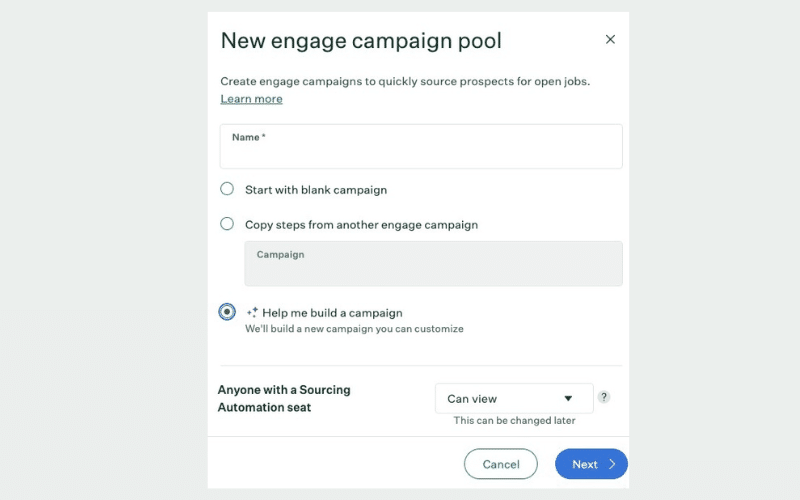
On March 29, 2024, Greenhouse launched a Campaign Creation Tool that allows recruiters to proactively prepare initial drafts of candidate communication events in advance, aiming to speed up recruitment activities.
The Campaign Creation Tool accelerates candidate outreach, helping recruiters engage with top talent rapidly. This update boosts user productivity and helps streamline hiring workflows, allowing teams to process higher volumes of candidates at scale.
Verdict: Hot! This new feature will help Greenhouse users speed through candidate communications without sacrificing the quality of their messaging.
Pinpoint Update Notes

On March 25, 2024, Pinpoint launched a Group Assessments feature. This update simplifies the process of coordinating in-person group assessment sessions for recruiters, making it possible to send invitations and manage logistics for group sessions directly through Pinpoint. Recruiters can also track attendance and limit the capacity for each session so they're never overbooked.
The significance of this update is its capacity to ease the burdens of group scheduling, traditionally a complex task. By overcoming scheduling roadblocks, Pinpoint accelerates the recruitment process, allowing for faster and more effective candidate evaluations. Group assessments are also a valuable addition to the recruitment process, particularly for roles requiring strong teamwork and communication skills, helping companies identify the best candidates more efficiently.
Verdict: Hot! Scheduling group assessments is always a pain, but this update makes the process a lot more straightforward.
Rippling Update Notes

On March 26, 2024, Rippling introduced a new Candidate Feedback Summaries feature that synthesizes multiple interviewers’ evaluations into a unified summary that highlights key strengths and weaknesses of candidates, making it available in both the feedback tab and final approval workflow.
This update uses advanced AI to quickly and automatically synthesize feedback from multiple sources into a coherent summary, significantly speeding up the final steps of the candidate evaluation process. This, ultimately, supports more efficient decision-making and faster hiring processes, enhancing the effectiveness of recruitment efforts and improving overall hiring outcomes.
Verdict: Hot! This handy feature eliminates the need to compare candidate notes from multiple sources to reach a group consensus, making it easier to find the best fit for each role.
Zoho Recruit Update Notes

On March 14, 2024, Zoho Recruit introduced "Refine Match," an enhanced candidate shortlisting process driven by ZIA, Zoho's artificial intelligence assistant. This feature helps recruiters filter candidates using pre-defined criteria such as skills, work experience, location, and other specific keywords, helping recruiters quickly and accurately assess candidates for job suitability.
This update is particularly valuable to users as it optimizes the recruitment process by saving time and improving the quality of candidate matches. Recruiters can expect a more precise shortlisting process, leading to better hiring decisions and ultimately, a stronger workforce.
Verdict: Hot! This feature leverages AI to improve candidate matching, leading to better long-term hiring outcomes, which is always a win!
February 2024: ATS Software Updates
BambooHR Update Notes

On February 15, 2024, BambooHR launched the AI eNPS Insights feature, an enhanced suite of tools for analyzing employee sentiment using AI. Designed to reduce the manual effort typically required to analyze employee feedback, this update introduces AI Topic Summaries for Employee Satisfaction with eNPS, which helps HR teams simplify and categorize employee feedback across different groups and departments.
The new AI eNPS Insights feature improves efficiency by automating the analysis process and delivering precise feedback insights. It empowers HR leaders to act swiftly on data-driven strategies that enhance employee morale and retention, thereby fostering a more productive workplace environment.
Verdict: Not hot - at least not for recruiters. While this update is useful for other BambooHR use cases, this feature doesn't apply to recruiters.
ClearCompany Update Notes
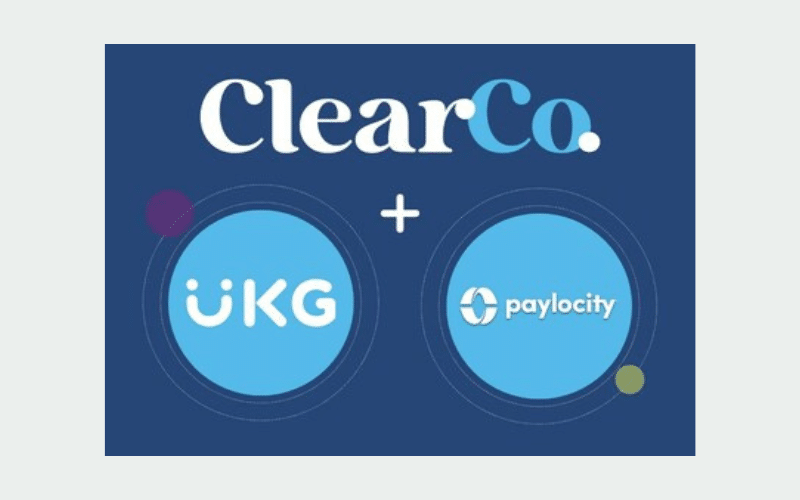
On February 22, 2024, ClearCompany launched new payroll integrations with UKG Ready and Paylocity, extending the reach of their talent management platform. These integrations sync employee data automatically between ClearCompany's system and the payroll providers, enabling bidirectional data exchanges and ensuring accurate and up-to-date data in both paired systems.
For existing ClearCompany users, these new integrations reduce manual efforts, such as updating changes to employee data in multiple systems, giving HR teams more time to focus on strategic talent management instead of data management.
Verdict: Not hot. While new integrations are always appreciated, these particular integrations won't impact the recruiting process.
Manatal Update Notes

On February 25, 2024, Manatal updated the Duplicate Management System within its ATS, adding a new tag called "not a duplicate." This new tag, while simple, helps reduce confusion within team-based hiring situations.
Using this tag, in-house recruiters can quickly see that a potential duplicate candidate has already been verified by a colleague and determined to be distinct, i.e., not a duplicate. This new addition works alongside Manatal's candidate auto-merge feature, which identifies possible candidate duplicates based on key details such as their name, phone number, or email address.
This small, yet useful update increases the flexibility of Manatal's ATS, helping teams improve their efficiency and avoid wasting time re-checking candidate data that's already been verified. In parallel, it also improves the overall integrity of candidate data, giving teams confidence that their talent pools are free of errors or unnecessary clutter.
Verdict: Hot! Sometimes a change can be small, but mighty, improving the overall user experience without changing anything fundamental.
Frequently Asked Questions About Applicant Tracking Systems
Here are some answers to frequently asked questions you may have about applicant tracking software and how it works:
How do applicant tracking systems work?
Applicant tracking systems manage the process of filling a job opening by aggregating job seeker data from third-party sources (like LinkedIn, Indeed, or Yello). They also incorporate advanced tools to help you categorize candidate information to uncover the best candidates in the mix.
Simply put, an ATS system works by fulfilling relevant recruiting process needs. It might include features such as a recruitment CRM, talent acquisition, human resource management, talent management, metric-based recruiting, candidate experience, and predictive analytics. This type of software is often described more generically as recruiting software or talent acquisition software.
Once your candidates are in your system, the ATS will include tools to advance candidates through each phase of the recruiting process for every vacant position. These phases often include:
- candidate sourcing
- candidate screening
- skill assessments or pre-employment testing
- interview scheduling
- reference checking
- distributing offer letters, and
- onboarding.
Applicant tracking software may encompass all or just a few of the following processes: job posting, resume parsing and collection, qualification analysis, employee referral programs, interview scheduling, and CRM (candidate relationship management). More advanced systems can even link your new hires directly into your orientation and onboarding software platform too. Either way, the main goal of an ATS is to give you an intelligent framework to keep your candidate data tracked and organized.
Are there different types of recruitment ATS software I should consider?
Yes, there are! And luckily for you, we’ve already done a lot of the research for you. To help you find the best applicant tracking system for you, here are some link that cover other types of ATS and recruiting software you should also consider, and why:
- Applicant tracking systems for small businesses might be a better fit for you if you’re recruiting on a smaller scale or working within a tight budget. The top applicant tracking systems in this were specially selected with SMBs (small to medium businesses) in mind.
- Diversity recruiting software is another type of recruiting tool that helps you source job applicants from a more diverse pool of candidates. This type of recruiting software is an excellent choice if you’re looking to develop more inclusive hiring practices and improve your diversity, equity, and inclusion (DEI) metrics.
- Recruitment marketing software is another subset to consider if you’re hiring for open positions in a very competitive industry. These recruiting platforms include robust tools to help you promote your open jobs far and wide, including through social media, popular talent networks, and career sites. These systems include extra bells and whistles to help you entice candidates to apply, including rich job descriptions and tools to highlight your company culture.
- Staffing software for staffing & recruiting is also a good list to browse over if you’re looking for software suggestions for a recruitment agency or hiring firm. These user-friendly systems are purpose-built to handle high-volume recruiting and staffing at the enterprise-level scale.
Why use an applicant tracking system?
Beyond the benefits listed above, one of the main reasons why you can consider using an ATS is to create consistency in your process. You can establish clear workflows for how candidates will move through the recruitment and hiring process, and track each one in the same way. This helps reduce human error and unconscious bias in your recruiting process.
Additionally, creating those clear workflows helps alleviate your recruiting team’s workload. Everyone will be following the same process, and the software’s automation features will reduce the manual work needed. For example, the software may be able to scan applications and notify recruiters when qualified candidates enter the pipeline. It can also handle your interview scheduling, and send consistent, automated communications out to candidates as they move through the process.
How do ATS platforms handle data privacy and security?
Applicant tracking systems prioritize data privacy and security by adhering to international standards such as GDPR in the EU, and using encryption methods for data transmission and storage. They also conduct regular security audits and compliance checks to safeguard data integrity, and offer role-based access controls to ensure that sensitive candidate information is only accessible to authorized personnel.
This article offers more details into data management best practices if you’re interested in learning more.
How customizable are ATS solutions for different industries?
ATS solutions are designed to be flexible, making them simple to cater to various industries. They allow customization in job postings, workflows, communication templates, and reporting metrics to meet specific industry needs. This adaptability ensures that whether a company operates in tech, healthcare, retail, or any other sector, the ATS can be tailored to streamline its unique recruitment processes and improve overall hiring efficiency.
If you’re looking for a specific industry, take a closer look at our in-depth reviews of Manatal, Greenhouse, or Tracker may be a good fit.
What kind of customer support do ATS providers offer?
Customer support offered by ATS providers typically includes a range of services such as 24/7 live chat, email support, dedicated account managers, and an extensive online knowledge base. Many providers also offer onboarding assistance, training sessions, and webinars to help businesses maximize the use of the system. This comprehensive support ensures that users can efficiently resolve issues and optimize their recruitment processes.
For more detailed insights into ATS platforms, I recommend contacting specific providers for a personalized quote that’s tailored to your specific needs.
Other Software Reviews
As you can see, there are a lot of options to consider when it comes to ATS systems and sourcing the best candidates for your open positions. And the fact that 98.9% of Fortune 500 companies use an ATS is also a strong indication of just how important these software systems are.
However, your journey doesn't have to stop here. If you're looking for a different type of applicant tracking or recruiting software, please take a look at my other specialty lists too:
- Cloud Recruitment Software for Hiring Teams
- Enterprise Recruitment Software for High Volume Hiring
- Recruitment Automating Software for Hiring
- Recruiting Database Software for Hiring Teams
- Recruitment Software for Small Businesses
- Recruiting Agency Software for Recruitment Firms
- Video Interviewing Software for Virtual Interviews
- Background Check Software
Other Resources
We also have loads of other resources to help you dive deeper into this topic, beyond just software. Here's a selection of our articles covering hiring best practices, written by industry experts:
- How to Approach Hiring & Recruitment When You Don't Have HR, a podcast with Joel Peterson, from Arbutus Search Group
- Recruitment Budgeting: Everything You Need to Know + Example
- Recruitment Marketing: What it is and 10 Effective Tactics
- The Key to Focused, Engaging Interviews (+ Template)
- Candidate Sourcing Tips To Help You Find The Best Talent
Before you go, make sure to subscribe to our People Managing People newsletter too. You'll stay up-to-date on all our latest articles, podcasts, tool recommendations, and best practices related to talent acquisition and management.


